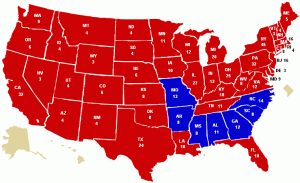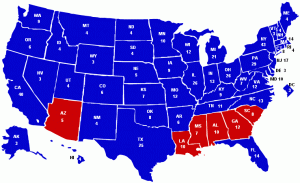 Allen West recently read “with a heavy heart” Hank Aaron’s comparison of the Republican Party to the KKK and offered him a history lesson. Other of my conservative friends have offered me the same lesson, pointing out that, for much of American history, opponents of civil rights voted with the Democratic Party, while the Republican Party is the “party of Lincoln.” I wanted to share what I’ve learned about how the Democrats largely lost the support of American racists. In doing so, I’m fearful of offending my Southern friends. I’d like to clarify from the start that not all or even most residents of the Deep South are racists. But, these states do tend to have a non-negligible block of voters who are, in no uncertain terms, racists.
Allen West recently read “with a heavy heart” Hank Aaron’s comparison of the Republican Party to the KKK and offered him a history lesson. Other of my conservative friends have offered me the same lesson, pointing out that, for much of American history, opponents of civil rights voted with the Democratic Party, while the Republican Party is the “party of Lincoln.” I wanted to share what I’ve learned about how the Democrats largely lost the support of American racists. In doing so, I’m fearful of offending my Southern friends. I’d like to clarify from the start that not all or even most residents of the Deep South are racists. But, these states do tend to have a non-negligible block of voters who are, in no uncertain terms, racists.
Before that, I’d like to point out what a ridiculous idea this really is. The people who doubt the historic interpretation I’m about to relate would rather believe that the men and women who marched with Martin Luther King like John Lewis and Jesse Jackson suddenly became racists and joined the Democratic Party. Every week the right-wing media reaffirms the Right’s commitment to last century’s ideas on race in their coverage of Trayvon Martin, Ferguson, immigration and anything related to Islam. So, here’s the history.

Beginning at the end of Reconstruction through 1948, the Deep South had voted for the Democratic Party. The 1928 elections were a bright spot for Republicans. (I’m going to use examples from Presidential politics because there’s less data to parse and I’m more familiar with it.) Herbert Hoover defeated his opponent, Alfred Smith even in his home state of New York. Hoover even won in the Democratic strongholds of Texas and Florida. And yet Smith, a Democrat, still carried the states of the Deep South, Arkansas, Louisiana, Mississippi, Alabama, Georgia and South Carolina, as had every Democratic Presidential candidate since 1880. These states would continue to vote for Democrats in every Presidential election until 1948.
Race and Politics
In that year, Harry Truman, a Democrat, split the Democratic party by supporting desegregation of the military and a civil rights bill. Strom Thurmond of South Carolina led the State’s Rights Democratic Party (the Dixiecrats) and ran for President against Truman, but lost. Thurmond would later switch to the Republican Party and serve in the Senate until 2003. After this, the Southern states returned to the Democratic Party for a few cycles until the Civil Rights Act of 1964. When it was passed, the Civil Rights Act had more support in the Republican Party than in the Democratic Party. Democratic President Lyndon Johnson supported it with some reluctance fearing it would damage his Party in the South.
In that same year, 1964, Barry Goldwater, a conservative Republican for the ages, challenged Johnson for the Presidency. In the short run, Goldwater’s bid was quite unsuccessful. He won only his home state of Arizona and five Southern states protesting Johnson’s signing of the Civil Rights Act. Goldwater, like Ron Paul, had opposed the Civil Rights Act on the grounds that the federal government should not interfere in such State matters and the economic and social forces would desegregate society in the long run. Martin Luther King, Jr. and many other civil rights leaders were not so sanguine and strongly encouraged voters to support Johnson. The comparison of the electoral map in 1956 and 1964 shows just what a radical change 1964 was. Thanks to 270towin.com for the maps.


This “states rights” theme has become an integral part of the modern Republican platform, with its members arguing for a narrowing of the authority of the federal government. Democrats often argue that some issues, civil rights included, are compelling enough that the federal government should intervene to protect the rights of individuals against the tyranny of local state majorities.
Nixon’s Southern Strategy
In 1968, the civil rights debate was still roiling. Richard Nixon followed Goldwater’s lead and emphasized state’s rights over federal authority. Segregationist Alabama Governor George Wallace (a fascinating historical figure and complicated man), ran an independent campaign and won electoral votes from the Deep South. Nixon won the remaining Southern States except Texas, and the election.
Not long after this election, a Nixon political strategist, Kevin Phillips, signaled his intention to abandon the black vote altogether. He even went so far as to say that the presence of blacks in the Democratic Party would drive racist whites to the Republican Party:
From now on, the Republicans are never going to get more than 10 to 20 percent of the Negro vote and they don’t need any more than that…but Republicans would be shortsighted if they weakened enforcement of the Voting Rights Act. The more Negroes who register as Democrats in the South, the sooner the Negrophobe whites will quit the Democrats and become Republicans. That’s where the votes are. Without that prodding from the blacks, the whites will backslide into their old comfortable arrangement with the local Democrats.
The South did return to the Democratic Party to elect Jimmy Carter of Georgia to a single term, and Southerners Carter and Bill Clinton won their home states in their Presidential bids, but from this point, the South moved inexorably toward the Republican Party. Reagan and George H. W. Bush continued to emphasize minimal federal intervention in State issues. The overt racist appeals were gone, although accusations of implicit or “dog-whistle” racial appeals have been levied.
Ann Coulter has some alternate theories about this switch. It is that the South moved Right with the emergence of a wealthy suburban class who signed on to the Reagan revolution with it’s promises of a less intrusive federal government. Meanwhile, Strom Thurmond and KKK grand wizard and Republican state representative David Duke misunderstood or overlooked the racially progressive Republican agenda and signed on. At the same time, 88% of African-Americans were fooled into signing on to the Democrats’ new and subtler racial oppression via social programs. The reader may judge for herself between these two theories.
Today’s Grand Old Party
Now, I don’t go in for the accusations that the GOP membership are predominantly racists. I know a lot of Republicans and that’s not my experience at all. The important difference where race is concerned is that Democrats believe racism exists. The Republicans do not, which puts them in a quandary. Minorities, including and especially African-Americans, clearly achieve, on average, less than whites in this country and Republicans are caught scrambling for an explanation for this.
Thomas Sowell thinks it’s the welfare state itself that holds African-Americans back. He often points out that unemployment for blacks was lower than for whites in 1930 (although just in that isolated year). According to Sowell, the change was a result of the Davis-Bacon Act of 1931, which established the first federal minimum wage. This ignores the mountains of progress toward racial equality of all kinds through the 1940s, 50s, 60s and 70s, even as the welfare state was growing. Further, the data do not suggest that States with lower minimum wage have a smaller racial wage gap.
Others fare much worse than Dr. Sowell. When Mitt Romney talks about “cultural differences” explaining the differential success of Palestinians and Israelis, he’s trying to convince you that, while he doesn’t attribute the Palestinians comparatively worse situation to racism, he’s also not like those racists who would say the Palestinians are genetically inferior. You’re not genetically inferior, you’re culturally inferior. See? Don’t you feel better?
And then, of course, the proof is in the pudding. If the Democratic Party were full of closet racists, their policies would be repugnant to minorities. Instead, racial minorities, both those that underachieve and those that overachieve, support the Democrats. Those poor ignorant minorities–snookered by those schemin’ Democrats again.
